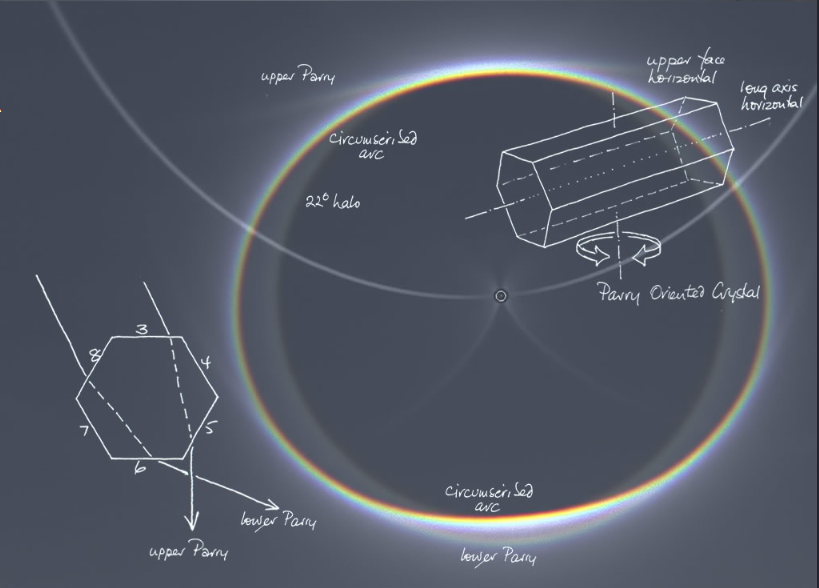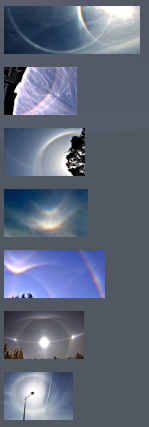OPOD - High Moon Parry Arcs
OPOD - High Moon Parry Arcs
Have you ever witnessed the ethereal beauty of high moon Parry arcs? These rare atmospheric optical phenomena occur when light interacts with hexagonal ice crystals in the atmosphere, creating captivating arcs of light around the Moon. While the circumscribed halo from column crystals is certainly awe-inspiring, it is the faint loop of light below it that steals the show – the elusive lower Parry arc. In this article, we will delve into the fascinating world of high moon Parry arcs, exploring their formation, characteristics, and the conditions necessary for their observation.
The Rarity of High Moon Parry Arcs
Spotting an upper Parry arc during daylight is already a remarkable event, but witnessing a lower arc by moonlight is even more extraordinary. These elusive phenomena require specific conditions to manifest themselves. A high moon and a dark sky are essential prerequisites for observing high moon Parry arcs. The moon should be at an altitude of around 57° to provide the optimal angle for light to interact with ice crystals in the atmosphere.
Routes of Ray Generation for Parry Arcs
Depending on the altitude of the Moon or Sun, there are four possible routes through which rays can generate 22° Parry arcs. To understand these routes, we need to examine the structure of hexagonal ice crystals. Conventionally, the side faces of these crystals are labeled from 3 to 8, while the end faces are labeled 1 and 2. In Parry-oriented crystals, the uppermost face is labeled as 3, and it is crucial for the formation of both upper and lower Parry arcs.
The ray path for the lower Parry arc involves entering a sloping face of the crystal and exiting through the lower horizontal facet. In the diagram, this corresponds to the (8,6) face, which is equivalent to (4,6). On the other hand, the ray path for the upper Parry arc follows the (3,5) face. These distinct ray paths create the mesmerizing display of high moon Parry arcs.
Exploring the HaloSim Ray Tracing
To gain a deeper understanding of the intricate behavior of high moon Parry arcs, researchers and enthusiasts have employed advanced ray tracing techniques. One such tool is HaloSim, which allows for the simulation and visualization of atmospheric optics phenomena. By inputting various parameters such as crystal orientation, light source altitude, and atmospheric conditions, HaloSim can generate accurate representations of Parry arcs.
By utilizing ray tracing simulations, researchers have been able to confirm the existence of both upper and lower Parry arcs. These simulations provide valuable insights into the complex interplay between light and ice crystals in the atmosphere, enhancing our understanding of these captivating optical phenomena.
Conclusion
High moon Parry arcs are truly celestial wonders that delight and inspire observers fortunate enough to witness them. The rarity of these phenomena adds to their allure, making each sighting a cherished experience. By understanding the routes of ray generation, the structure of ice crystals, and employing advanced ray tracing techniques, we can unravel the mysteries behind these mesmerizing arcs of light. So, keep your eyes on the night sky during a high moon, and who knows, you may be fortunate enough to catch a glimpse of the elusive lower Parry arc.

High Moon Parry Arcs
Lunar halos imaged by veteran observer, Michael Ellestad. The circumscribed halo from column crystals is spectacular but is not the star of this show. Look below it for a faint loop of light, a rare lower Parry arc. ©Michael Ellestad, shown with permission.

An upper Parry arc in daylight is a rare sighting. A lower arc by moonlight even more so. A high moon and a dark sky are needed – here the moon was 57° high.
Depending on the lunar or sun altitude, there are four routes by which rays can generate 22° Parry arcs.
Hexagonal ice crystal side faces are, by convention, labelled from 3 to 8. The end faces are 1 and 2.
In Parry oriented crystals the near horizontal uppermost face is 3. The lower Parry arc ray path is into a sloping face to leave through the lower horizontal facet. This is (8,6) in the diagram which is equivalent to (4,6). The upper arc‘s ray path is (3,5).
At right, the HaloSim ray tracing shows the two Parry arcs


Note: this article has been automatically converted from the old site and may not appear as intended. You can find the original article here.
Reference Atmospheric Optics
If you use any of the definitions, information, or data presented on Atmospheric Optics, please copy the link or reference below to properly credit us as the reference source. Thank you!
-
<a href="https://atoptics.co.uk/blog/opod-high-moon-parry-arcs/">OPOD - High Moon Parry Arcs</a>
-
"OPOD - High Moon Parry Arcs". Atmospheric Optics. Accessed on November 21, 2024. https://atoptics.co.uk/blog/opod-high-moon-parry-arcs/.
-
"OPOD - High Moon Parry Arcs". Atmospheric Optics, https://atoptics.co.uk/blog/opod-high-moon-parry-arcs/. Accessed 21 November, 2024
-
OPOD - High Moon Parry Arcs. Atmospheric Optics. Retrieved from https://atoptics.co.uk/blog/opod-high-moon-parry-arcs/.